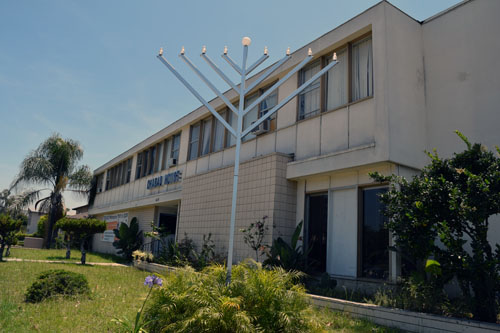
-32nd in a series-
Exit 10, College Avenue, San Diego ~ Chabad at SDSU
By Donald H. Harrison
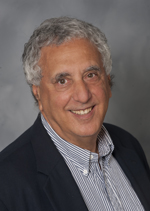
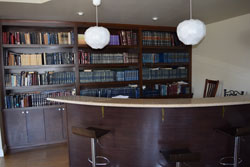
SAN DIEGO – The large menorah standing two stories tall on the front lawn immediately differentiates this house at 6115 Montezuma Road from the fraternity houses nearby. And if you go inside to the large, comfortable sitting room, one look at the bar will confirm that the parties thrown here definitely are not booze fests.
Instead of liquor bottles behind the bar, there are shelves of leather-bound Jewish books. “I’ll have a Tanya, please,” one can imagine a visitor saying.
This house is the Chabad House that serves San Diego State University. Rabbi Chalom Boudjnah has been building the congregation since arriving in San Diego in 1999 at the invitation of Rabbi Yonah Frandkin, whom he succeeded following a two-year apprenticeship.
Fradkin today serves as the senior Chabad rabbi in San Diego County, which from an organizational standpoint makes him the “boss” of the other Chabad rabbis in the county. He is based at the Chabad Hebrew Academy in Scripps Ranch.
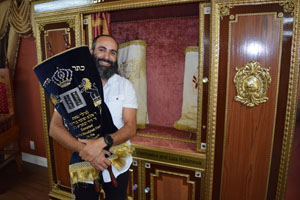
The Boudjnahs’ connection to this particular Chabad House predated the arrival of the French-born Rabbi, although this wasn’t immediately apparent to Rabbi Chalom and Mairav Boudjnah. Early in Rabbi Fradkin’s tenure at San Diego State University, Bat Sheva Zalkind, a Jewish student from Cape Cod, Massachusetts, was on a spiritual quest. After enrolling at San Diego State, she had flirted with Eastern religions, and one day, noticing the Rabbi putting on tefillin, she asked him the meaning of this ritual.
This led to a discussion of Jewish spirituality, Kaballah and reincarnation, and before long, the student became a regular visitor to Chabad House, ultimately deciding she had found in her own religion exactly what she was looking for. After about a year of study with Rabbi Fradkin, she eventually went to Minnesota to study under Rabbi Manis Friedman at the Bais Chana Institute of Jewish Studies, which specializes in teaching Judaism to women with very little background in their religion. From Minnesota, she went to Israel to complete her studies and there married Rabbi Drori.
Many years later, after her daughter Mairav became of marriageable age, Mrs. Drori met in New York City with Rabbi Fradkin’s sister-in-law who serves as a shadchan, or matchmaker. About the same time, the shadchan also met Rabbi Boudjnah. She decided to put one and one together, without any of the parties realizing that Boudjnah was serving as assistant to the very same Rabbi who had helped Mrs. Drori find her way back to Judaism. It was only after Mrs. Drori started asking many questions about Boudjnah’s background and prospects that her family’s life was to turn a full circle. Rabbi Chalom and Mairav Boudjnah eventually would play the same mentoring roles in the life of SDSU students that Rabbi Fradkin had played in that of Mrs. Drori.
Being there for students in times of trouble, or loneliness, or crisis is an important aspect of the Boudjnahs’ lives.
Rabbi Boudjnah told me of one young man. “He recently lost his mother and we had to take care of everything for him. He is a single boy, with no father, so he was alone.”
On other occasions, the Rabbi said, he and the Rebbetzin help students facing different levels of hardship or adversity, for example, “a girl who broke up with her boyfriend and she just wanted to talk to someone besides her friends or her mother. So Mairav does that, and I do the same with the boys.”
There was also a boy “whose father went to prison and he had a very hard time with that morally,” Rabbi Boudjnah recalled. “There are all kinds of different issues and these kids are just 18 or 19 years old. They think they are adults, and they are young adults, but they just left home, and so it is nice that they have someone to come to. We have a family, and so they have a family. For us, they are just like family, and we’re not just a Rabbi and Rebbetzin It’s not a one-man show. We love each of them. We care about them, and the advice I would give them, I would give to my own kids.”
At the time I visited Chabad House, the Boudjnahs had six children, four girls and two boys. The eldest, Sara Batya, was 13 in 2015. She was named after a great-great grandmother. Next came Chana Rachel, 12, also named for a great-great grandmother. When Chaya Luba finally came along, the couple gave her a name meaning “life and love” or “love of life” in celebration. “Luba is also after Lubavitch, where Chabad started,” the Rabbi said.
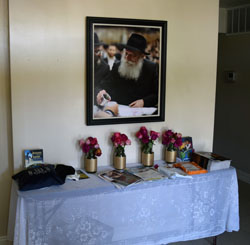
Next came the first son, Menachem Saadya, Boudjnah said. The name “Menachem” honors the late Lubavitcher Rebbe, Menachem Mendel Schneerson, especially when linked with Rabbi Boudjnah’s own middle name which is “Mendel.” The boy’s middle name, Saadya, was after Mairav’s grandfather, “who was born in Yemen, a holy man, whom even the Arabs used to go to see him to pray for rain. He was an amazing person.”
The next child born to the Boudjnahs was Shoshana Nadra, the middle name being Yemenite in origin, and meaning light. That was the name of Mairav’s grandmother, who had passed away two years before the baby’s birth.
Finally, there was a second boy, Dovber, who was a large baby, in the 95th percentile of weight. Dov and Ber both mean “bear,” one in the physical sense, the other in the spiritual sense. Putting the two names together “the spiritual is supposed to overcome the physical,” Boudjnah explained.
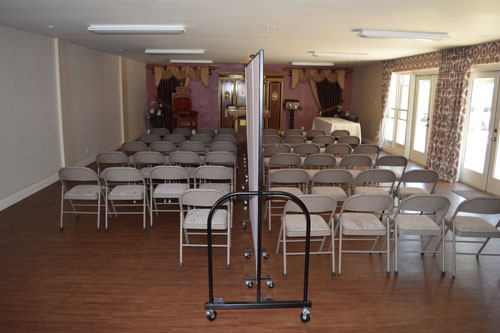
There are 15 bedrooms upstairs in the Chabad House. The Boudjnahs have a separate home within walking distance of Chabad House. The upstairs bedrooms at Chabad House are rented to college students and other single men living in the neighborhood. These tenants, in addition to Jewish students from San Diego State University and Grossmont College in El Cajon, as well as other community members, are invited on alternating Friday nights to Shabbat dinners. On these occasions, the mechitzah is rolled away, and tables and chairs are laid out in the pattern of the Hebrew letter “shin” so that as many as 140 people can be accommodated in the sanctuary for kosher dinner.
The free dinners are times when students are exposed to the joy of Jewish life and much singing accompanies the meal, Boudjnah said, his eyes sparkling.
The idea is not to turn Jewish students into Chabadniks, but instead to familiarize them with Judaism and the mitzvoth, the Rabbi said.
Boudjnah told of one very strict Orthodox man, who was not a member of the Chabad movement, who watched disapprovingly as students danced on Simcha Torah with the Torahs. Taking Rabbi Boudjnah aside, he commented that the students didn’t look religious, that they probably didn’t keep kosher, or keep the Shabbat or go to synagogue. So why, he asked, would they be permitted to dance with the Torah? Commenting that Chabad believes that “one mitzvah leads to another,” Boudjnah said the fact that the students were not religious, and still wanted to dance with the Torah, meant wonderful Jewish things may continue to be in prospect for them.
The reason that Chabad serves kosher meals every other Friday night, rather than every week, is because, by agreement, the Hillel organization of San Diego welcomes students on the alternate Friday nights. Boudjnah said rather than being in competition, Hillel and Chabad expose students to different faces of Judaism – Hillel typically is non-Orthodox. There were some unexpected benefits in working so closely with Hillel, he added. Whereas some students were reluctant to visit Chabad on their own, fearing that Orthodoxy is too strict for them, they were willing to come with friends from Hillel on the alternate weeks. Once at Chabad, they enjoyed the warm and cordial atmosphere, Boudjnah said, and then were willing to attend other events.
Besides students, the Chabad House serves a small community of Bukharin Jews, who immigrated to the United States from some of the Asian Republics of the former Soviet Union. The Bukharin Jews follow a Sephardic rite, with which Boudjnah, a French Jew of Algerian ancestry, feels very comfortable. He has become the life-cycle rabbi for this small community, officiating at their weddings, brit milah ceremonies and funerals.
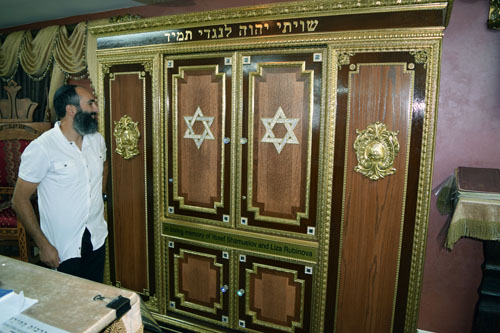
In appreciation, members of the Bukharin community built for the Chabad House a finely decorated Aron Kodesh as well as a ceremonial Elijah’s chair for brit milah.
Such donations are the mainstay of a Chabad House. The rabbi, known as a shaliach, or emissary, and his wife are expected to support themselves through fundraising. They neither receive funds from nor are expected to donate funds to Chabad’s headquarters in Brooklyn. Boudjnah said there never is any money left over, and if there were, he would not be doing his job right. Whenever there is money, Chabad expects it to be spent wisely on Jewish programming.
Besides the Shabbat meals, Boudjnah offers on the other four weekdays at the Chabad House a kosher meal plan in which so far 20 students are enrolled.
“My mission is to reach out to as many Jews as possible and to give them a positive experience about Judaism,” he says. “Mainly we focus on college students because we are right next to campus. I am honorary brother for AEPi, the Jewish fraternity at this campus, and we do a lot of events.”
A class is offered at Chabad House about the “moral values that the Ten Commandments brought to the world,” and Chabad House sponsors social events such as a “welcome back” beach barbecue. “We jet ski and play volleyball at the beach so we reach out to them in many different ways. We have minyan on Shabbos on Friday night and Saturday, but also on Sunday morning and Sunday night, which we combine with a class.”
Boudjnah said Chabad House is “not a full-on community; there are perhaps 30-40 people who come for services on Shabbos, not a huge number, but it is a close group of people from different backgrounds. There are a couple of people who are Chabad and there is a family who are Israelis. Some are single guys or single women who come here. And we have the Bukharin community.”
The rabbi said that except in rare instances, Chabad emissaries make a career-long commitment to the community that they have built up, rather than jumping from post to post. He and Mairav plan to stay at San Diego State and to continue to build up the College Area community of San Diego and nearby cities. Were they to leave, he said, the people who have been attracted to Chabad because of its family atmosphere might feel bereft.
From Interstate 8: Take College Avenue south to Montezuma Road and turn left. Chabad House will be on the left.
Next: The ritual baths at Mikvah Israel
*
Harrison is editor of San Diego Jewish World. You may comment to him at donald.harrison@sdjewishworld.com, or post your comment on this website provided that the rules below are observed.
__________________________________________________________________
Care to comment? We require the following information on any letter for publication: 1) Your full name 2) Your city and state (or country) of residence. Letters lacking such information will be automatically deleted. San Diego Jewish World is intended as a forum for the entire Jewish community, whatever your political leanings. Letters may be posted below provided they are responsive to the article that prompted them, and civil in their tone. Ad hominem attacks against any religion, country, gender, race, sexual orientation, or physical disability will not be considered for publication. There is a limit of one letter per writer on any given day.
__________________________________________________________________